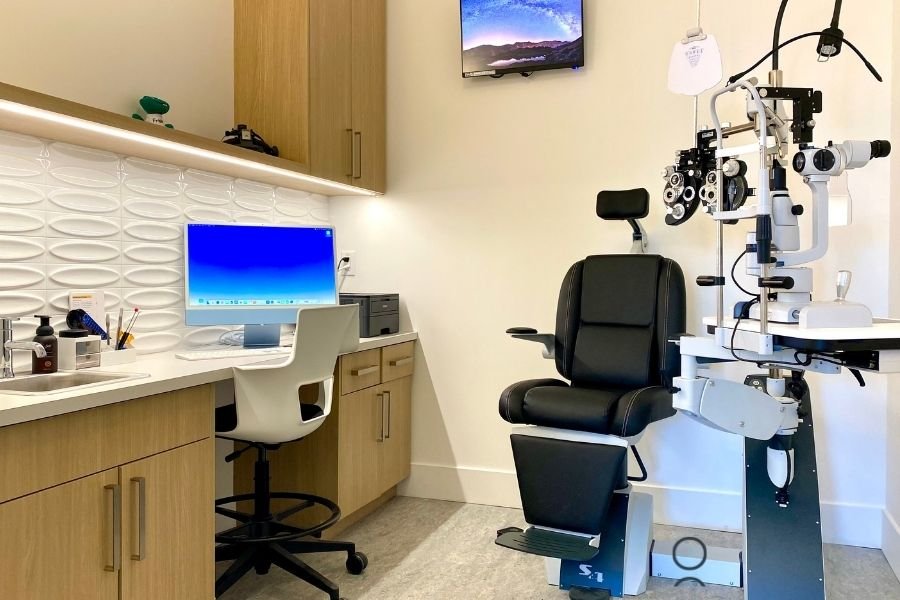
Same-Day Glasses Edmonton
Start at only $175
When Your Vision Can’t Wait: Fast, Same-Day Eyeglasses Ready When You Need Them
At Helio Optometry, we know your time is valuable. That’s why we offer same-day single-vision glasses service, so you can enjoy clear vision and great style without the wait. Thanks to our in-house edging lab, we can deliver premium lenses in about half the time!
Same-day Glasses Starting at only $175
Price includes an Aperture frame, scratch-resistant non-glare single-vision lenses, and same-day service.
Advanced Lens Technology, Here and Ready for You
State-of-the-Art On-Site Lens Finishing Lab
We’re more than just eye exams—we’re redefining the eyewear experience. With state-of-the-art optical technology, we finish all of our lenses right here on-site. Our advanced equipment gives us full control over the eyewear-making process, ensuring unmatched precision, faster turnaround times, and a truly customized final product. Quality, speed, and care—delivered seamlessly from start to finish.
A Wide Range of Lenses and Frames
Explore our extensive collection of frames, from timeless classics to bold, trendy designs. Paired with our high-quality Aperture lenses, we’re ready to meet a wide range of vision needs with clarity and style.
For specialized prescriptions or multifocal lenses like bifocals and progressives, we’ll custom-order your lenses. The best part? We can still have your glasses ready in just a few days—about twice as fast as big chain stores!
Your ideal eyewear is just around the corner. Let us help you see and look your best!
From Prescription to Perfect Vision in One Day
Eye Exam: Start by booking a same-day eye exam with one of our optometrists to ensure that your prescription is up to date, or bring in a copy of your current eyeglass prescription.
Choose Your Frames: Pick your perfect frames from our diverse selection, or you can use your own.
Lens Customization: We'll cut your selected lenses using our on-site technology. This process includes lens fitting into your chosen frames, ensuring they meet our quality standards and your vision needs. No pressure points, loose spots, or gaps. Our same-day service includes all classic and mid-index single-vision lenses.
Ready to Wear: Walk out with your new eyeglasses the very same day!
Outside prescriptions are always welcome, and no appointment is required. We can also contact your last optometrist to get your information for you.
Need Your Eyeglasses Right Away? We've Got You Covered!
In the rush of daily life, sometimes you can't wait for new glasses. Whether you're replacing a broken pair, updating your style, or needing a quick change in prescription, we're here to help – fast.
📞 Do You Have An Urgent Eyewear Need? Call us at 780-628-6855. Let us know what you require, and we'll confirm on the spot if we can deliver your glasses on the same-day.
Why Choose Helio Optometry for Same-Day Glasses & Eye Exams?
Speed and Convenience: Get your new glasses fast, on your schedule.
Quality and Precision: Advanced technology meets craftsmanship.
Service and Care: Our experienced team is dedicated to ensuring you leave satisfied and seeing clearly.
Variety and Style: A wide selection of frames to match every taste and need.
We offer same-day eyeglasses starting at only $175, including frame and non-glare, scratch-resistant single-vision lenses. Visit our Aperture collection page to learn more.
Same Day Eye Exams Edmonton
Don't let your vision needs wait another day. Experience the convenience of same-day eyeglasses and eye exams at Helio Optometry eye care clinic in West Edmonton. We're here to provide you with the best in fast, reliable, and quality eye care.
Book your same day appointment or drop by today — your new glasses could be just minutes away!



